Gayle Irwin's Blog, page 14
November 13, 2018
5 holiday pet safety tips
 We’ve entered Holiday Season 2018. Grocery stores are pulling out the turkeys and baking supplies for Thanksgiving, and big-box stores have set up Christmas trees. With Thanksgiving about a week away and Christmas only five to six weeks from now, this is a good time to remind pet parents of the dangers the holiday season can present to our furry family members.
We’ve entered Holiday Season 2018. Grocery stores are pulling out the turkeys and baking supplies for Thanksgiving, and big-box stores have set up Christmas trees. With Thanksgiving about a week away and Christmas only five to six weeks from now, this is a good time to remind pet parents of the dangers the holiday season can present to our furry family members.Here are five pet safety tips to be mindful of these next two months:
Be cautious with human foods. Although some foods, like turkey and pumpkin, are fine for pets, other edibles, like garlic and chocolate, are not. (more on this next week)Keep a lid on the trash. Enticing aromas from turkey bones and other foods may make your pet a garbage hound. Therefore, make sure the trash is out of your furry friend’s reach – poultry bones can cause great damage to an animal’s insides, and some animals die from ingesting such objects.Decorations can be dangerous. Therefore, keep them out of your pets’ reach. Candles, lights, tinsel, even some plants can harm our pets, especially if chewed/swallowed.Added noise and activity can cause anxiety. Make sure your pets wear identification in case they slip out of the door with guests coming and going; you may also want to set up a “quiet room” for your animals to go and get away from the crowds and activity.Anchor the tree. Some people erect their Christmas trees right after Thanksgiving; others wait until closer to Christmas. Whenever you put up your tree, make sure it’s securely anchored. Cats especially are attracted by sparkling lights and dangling decorations – their swatting, jumping, and playing can knock over a Christmas tree, so make sure it’s secure.
Make sure you know your veterinarian’s holiday hours and the phone number of the emergency vet clinic in your community in case something should happen. Another handy number to have is the ASPCA Poison Control Hotline: 1-888-426-4435. Although we hope nothing happens to our furry family members, having these phone numbers handy and knowing if your vet (or another) is available on-call is good information to have just in case.
Find more tips and helpful information regarding holiday safety at these websites:
https://www.avma.org/public/PetCare/Pages/holidays.aspx?utm_source=prettyurl&utm_campaign=holiday&utm_term=holiday
https://www.petfinder.com/dogs/dog-care/holiday-pet-safety-tips/
https://www.aspca.org/pet-care/general-pet-care/holiday-safety-tips
NEXT WEEK: A guest post from Katie at Personal Creations on Thanksgiving Food Do’s and Don’t’s for your pet, including creative food and treat ideas from your left-overs! Be sure to stop by! Meantime, check out the graphic below from Personal Creations for this week's blog post.
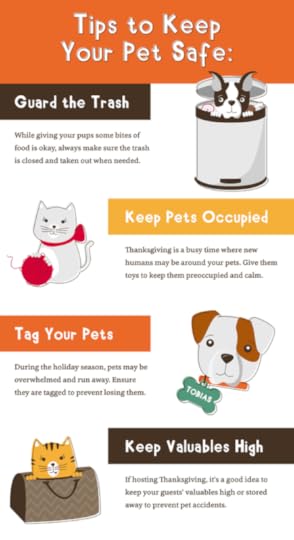
Published on November 13, 2018 05:30
November 6, 2018
dogs in the military
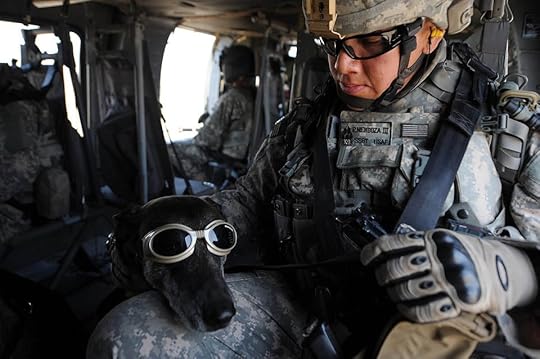 Many of us recognize some dogs have jobs, such as herding, hunting, and guarding. However, did you know some dogs serve in the U.S. military?
Many of us recognize some dogs have jobs, such as herding, hunting, and guarding. However, did you know some dogs serve in the U.S. military?According to an article by the American Forces Press Service, the United States Military uses more than 2,000 working dogs throughout the globe. The Department of Defense’s Military Working Dog Program, based at Lackland Air Force Base in Texas, deploys dogs and their handlers of the different branches of military service to various parts of the world. These teams safeguard military bases, help fight the war on terror, and detect bombs and other explosives. Because a dog’s sense of smell is so acute, they can detect the smallest trace of explosives and drugs, and they are trained to alert their handlers of such materials.
Dogs serving in the military isn’t anything new, even though their duties might be. Canines served in World War I and II as well as in Vietnam. They have been instrumental in Iraq and Afghanistan, and even in the capture of Osama bin Laden with the Navy Seals.
Different dog breeds have been used in military service, including Labs. Today’s military working dogs in the Defense Department program are primarily German and Dutch shepherds and Belgian Malinois. About 500 dogs are deployed at one time.
A memorial to dogs serving in war was dedicated in June 2006. It is found at the New Jersey Vietnam Veterans’ Memorial. Learn more here: https://www.njvvmf.org/us-war-dog-memorial/.
On Sunday, November 11, America celebrates Veterans Day. Let us take time to honor our human veterans as well as our military service dogs. Both display deep loyalty to country and to each other. Let’s not forget their sacrifice!
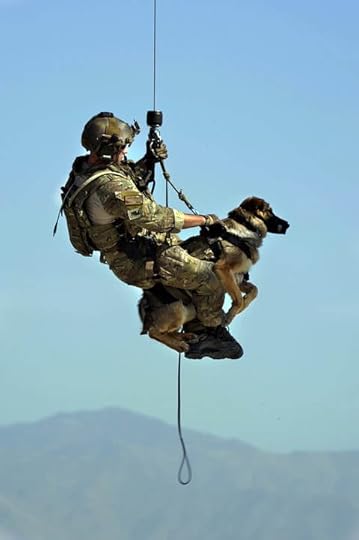
Published on November 06, 2018 04:30
October 30, 2018
halloween should be fun, not frightening
 It’s that time of year again, time for warm pumpkin-spice lattes, glowing jack-o’-lanterns, and fun, spooky costumes. Halloween is here, and though the day and evening should be fun, it can also be frightening, especially for our pets.
It’s that time of year again, time for warm pumpkin-spice lattes, glowing jack-o’-lanterns, and fun, spooky costumes. Halloween is here, and though the day and evening should be fun, it can also be frightening, especially for our pets.Our dogs and cats can become more scared than be scary during this time of year. Between haunting music and flowing, glowing costumes, our animals may end up being more frightened than Jamie Lee Curtis in Halloween!
The number one thing we can do to help our pets at this time of the year is to keep them safe and secure in our homes. With the doorbell ringing constantly by trick-or-treaters, the front door opening, and the get-ups those munchkins wear, our pets can bolt out the door in fear. So, keep your furry friends safe in a room in the house with comfortable bedding, familiar toys, and maybe some soft, soothing music playing.
Other ways to keep your pet safe on Halloween include:
Keep candy away from pets – if they eat it, they can be poisoned, as many types of human food are very harmful to animals.Keep candles and lit jack-o’-lanterns out of your pets’ reach – no one wants a house fire.Think of your cats especially regarding safety – pranksters and mischief-makers often do harm to cats on Halloween, another reason to keep pets securely indoors.
Read more Halloween safety tips from my blog last year here: http://www.gaylemirwin.com/blog/archives/10-2017.
Watch a video created by the American Veterinary Association here: https://www.avma.org/public/PetCare/Pages/halloween.aspx.

Published on October 30, 2018 05:24
October 23, 2018
Dog Bites – It’s all About Safety
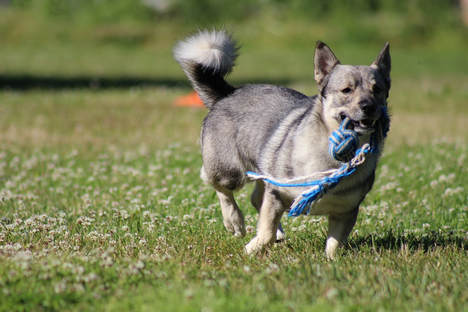
World Rabies Day was held last month, bringing about awareness of the danger of rabies in both people and animals across the world. Although humans in the U.S. contracting rabies is rare, it can and does happen.
One of my Montana friends has worked for an animal shelter in that state and volunteers with the shelter and helps other rescue organizations. I asked her to pen some thoughts about unvaccinated dogs, rabies, and other diseases that we should be concerned about if we are, or someone we love is, bitten by a dog. Below are some of her comments.
Everyone thinks of rabies when a dog bites, but that is only one of the diseases that can be inflicted.
Rabies: The most dangerous disease that people can contract through dog bites. While cases of rabies are rare, the disease is incredibly lethal. Rabies is a virus that affects the brain and once symptoms show, it’s almost always fatal. One of the most common ways to contract rabies is through the bite and saliva of an infected animal. Victims who have been exposed to an animal that could have rabies should immediately seek out medical treatment.
Capnocytophaga: This is a bacterium that lives in the mouths of humans, dogs, and cats. The bacteria don’t make dogs or cats sick, so it is not always easy to identify if your pet has it. The spread of Capnocytophaga to humans is rare. It’s typically spread through bites, scratches or close contact with a dog or cat. Most humans who do encounter dogs or cats do not become sick. However, people with a weakened immune system are at a greater risk of becoming sick.
Pasteurella: This is a type of bacteria seen in over 50% of infected dog bite wounds. The result is a painful, red infection around the bite area, but it can cause more severe conditions in people with a weakened immune system.
MRSA: Methicillin-resistant Staphylococcus aureus (MRSA) is a type of staph infection that is resistant to some antibiotics. Dogs and other animals can carry MRSA without showing symptoms. However, the bacteria can cause skin, lung, and urinary tract infections in people. In some, MRSA can spread to the bloodstream or lungs and cause life-threatening infections.
Tetanus: Tetanus is a toxin produced by a bacterium called Clostridium tetani. It can cause rigid paralysis in people exposed through deep bite wounds.
People need to remember that they are setting their animals up to fail when they allow them to get to the point of biting another person or animal. Yes, the victim may also be another animal.
Bite animals are quarantined as everyone waits and watches for signs of disease. The animal is confused about what happened and why it happened. Why are they now quarantined in a place that is not home with people who are not their family? The family has a hard time understanding that quarantine means NO contact by them, other animals, or ever the caretakers where the animal is held. The reason is simple: rabies can be transferred by an animal licking their fur and an individual then touching the fur. Plain and simple - rabies is a highly transmittable disease. The animal is NOT allowed to be comforted with the touch of anyone or thing for 14 days. Food and water are given without the door being opened. No bedding, towels, toys, etc. can be touched. At our shelter, we play soothing music during their stay and visit with them outside the cage; however, it isn’t the same as what happens when they are at home with their own family. For the dog, this situation is foreign and scary; many animals become depressed and anxious. Daily calls are made to the bite victim and to the family of the dog to let them know of the animal’s health and condition.
Why put your family, your animal, the victim and his/her family through all of this? It is always surprising to hear the reasons that an animal has NOT been vaccinated, especially for rabies, when we are called to an animal bite. “I just didn’t think that they needed to have the shot.” “We don’t believe in vaccinating.” “Animals are over-vaccinated in America.” Any one of these and more are reasons that we hear. My response is, “Was it worth it to not vaccinate your animal? To not have them at home with their family? To stress over whether you are going to have to pay for multiple injections into the bite site of the victim? To have your renter’s or homeowner’s insurance go up after the first bite and the second? Forget the third bite; the animal will be euthanized in most cities around the country. To have to put signs up in your yard about a vicious animal? To muzzle your animal when they are outside or go to the vet?
The sad fact is that many are under the false belief that their animals don’t need to be vaccinated because they never leave the house or the yard. This lack of understanding of disease prevention leads to many animals dying for no good reason. A simple vaccination can prevent days of fear and anxiety for a bite victim and their family, the owner of the animal that bit, and the community in general.
I appreciate my friend sharing her insights. May we all consider these thoughts and keep our pets healthy and free from disease, and our friends, loved ones, neighbors, and community safer.
Most towns and communities have ordinances and states/provinces have laws regarding vaccinations, vicious animal designations, and how animal control is to handle potential rabies situations. You may want to check such laws for where you live as you consider the vaccines recommended for your pets and educate others on this topic as well.

Published on October 23, 2018 15:11
October 17, 2018
can no-kill be achieved?
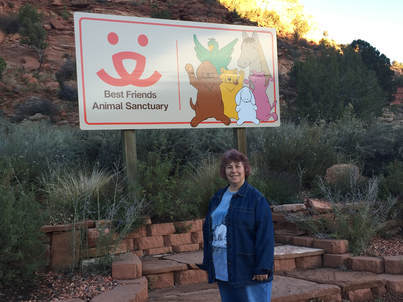 One of the most well-known national animal sanctuaries, Best Friends Animal Society, located in southeastern Utah, is about a 13-hour drive from where I live in Wyoming. I have visited twice and volunteered once. What an amazing place!
One of the most well-known national animal sanctuaries, Best Friends Animal Society, located in southeastern Utah, is about a 13-hour drive from where I live in Wyoming. I have visited twice and volunteered once. What an amazing place!For many years, Best Friends has been on the frontlines of the “No-Kill” movement, a vision of seeing that no healthy, adoptable animal is euthanized in America’s shelters. Recently, the non-profit organization turned up the volume, and the heat, to make no-kill a reality by 2025. Staff and volunteers believe that achievement is possible.
The main Best Friends sanctuary is located outside of the small town of Kanab, Utah, which itself is located within 20 miles of the Arizona border is southeastern Utah. The beautiful red sandstone rocks of that area, which includes Zion and Bryce Canyon national parks, offers a dazzling, inspiring backdrop to the 200+ acre sanctuary. This special place provides a temporary (and sometimes permanent) home for dogs, cats, rabbits, birds, horses, and other animals. This group took in more than 20 of the Michael Vick dogs, several of which were later re-homed with loving families. Best Friends has done so much good around the country, including opening new adoption centers in places like Los Angeles, Salt Lake City, and New York. Soon, a new Best Friends center will open in Houston. They partner with other animal welfare groups across the country, such as Austin Pets Alive! And most recently, a small Texas town that receives thousands of animals each year. Texas leads the nation in number of shelter animals killed each year, and Best Friends – among other groups – wants to make a positive impact for pets in that state.
The ASPCA (American Society for the Prevention of Cruelty to Animals) estimates the number of dogs and cats that enter animal shelters in the United States to be around 6.5 million; 1.5 million of those, including healthy, adoptable animals, are killed. That doesn’t have to happen. If adoption rates would rise above the current 50 percent, more positive outcomes for more animals would result.
Can no-kill hapen in America during the next seven years? Best Friends envisions such a possibility. With organizations like Best Friends Animal Society and adoption supporters throughout the nation like you and me, it can be done. Let’s all do our part to educate people about the joy of pet adoption and raise the mantra of #AdoptDon’tShop in our own communities as well as via social media. There are two weeks left of October’s Adopt-a-Shelter-Dog Month, and November brings Adopt-a-Senior-Pet Month. Think about one thing you can do to make a positive impact on shelter animals these next several weeks, and let’s help Best Friends attain the goal of #NoKill2025 – for the sake – and the lives – of these animals.
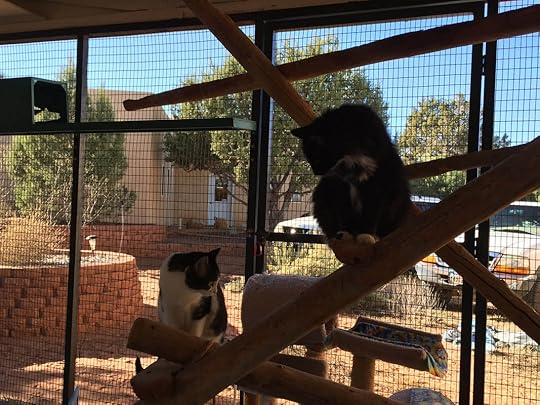
Published on October 17, 2018 09:58
October 9, 2018
5 questions to ask before adopting a dog
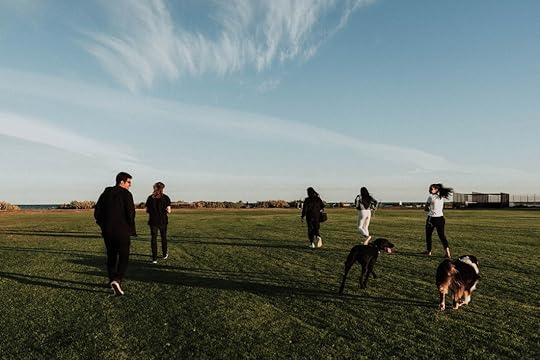 Those of us who are pet lovers know the warm, fuzzy feeling when we see a puppy or kitten at play or when we observe someone walking their dog in the neighborhood. We also know the joy in our hearts when we come home from work or school and our furry friend greets us at the door with wagging tail or a “welcome home” MEOW! Many of us pet-lovers have adopted a pet or two.
Those of us who are pet lovers know the warm, fuzzy feeling when we see a puppy or kitten at play or when we observe someone walking their dog in the neighborhood. We also know the joy in our hearts when we come home from work or school and our furry friend greets us at the door with wagging tail or a “welcome home” MEOW! Many of us pet-lovers have adopted a pet or two.Dog Adoption
I stopped watching Saturday morning shows years ago – but recently I started again. CBS carries a program called Lucky Dog; I began tuning in regularly after seeing a few episodes. Each week, Brandon McMillan brings a dog out of a Los Angeles animal shelter, trains it, and finds it a new home. This inspiring show and its host have won several awards, and the education provided is excellent.
October is Adopt-a-Shelter-Dog Month. Every year, nearly 3.5 million dogs (and just about as many cats) enter America’s animal shelters. Many thousands of others go into rescue. If you’ve been considering adopting a pet, particularly a dog, this is a great time to add a furry friend to your household. Many shelters discount their adoption fees during this month, encouraging more adoptions, and ultimately, saving more lives.
Ready to Adopt?
Here are five questions to ask yourself if you’re considering adopting a dog (or any pet for that matter):
Are you committed to the animal for the rest of its life? Although circumstances in our lives can change, commit to caring for your pet for its lifetime.Is your household prepared for a dog? Do you have a fenced-in yard in which a dog can play and do its business? Or, if you live in an apartment, does your landlord allow pets and are you willing to take the dog outside for walks, times in the park, and other ways for it to play, exercise, and do its business? This, too, takes time and commitment.Are you willing to expend money on your pet’s health? Just like people, dogs (and other pets) need medical care. Pet insurance is available to help as is Care Credit, something I use regularly. Yet, the bills need to be paid. Be prepared for medical expenses with a pet!Do you have adequate time to devote to a pet? Dogs, especially, require time and attention. They lavish our presence; therefore, you need to be willing to give plenty of time to your furry friend. Relaxation on the couch, playtimes in the yard and/or house, and fun times like drives, hikes, walks, and playdates at the park.Are you willing to invest in quality food for your pet? There are endless varieties of pet food, many of which are low-grade and have been documented for causing health issues, even death. Quality food costs money, but, in the long run, feeding better food will keep your dog from visiting the vet frequently and help it live longer, and therefore, keep you from paying more on vet bills. Some organizations regularly report on the best and worst brands of pet food. Start here to learn more: https://www.dogfoodadvisor.com/best-dog-foods/
If you answer “yes” to the above questions, then your decision to adopt a dog in need of a home is the right one! Begin your search locally for your next furry friend. Or, if you have a specific type of dog in mind, such as breed, age, sex, etc., go to Petfinder.com, put in your zip code and your pet parameters (i.e., adult, female, cocker spaniel) and see what this amazing database can find for you.
Adopting a dog saves two lives: the one being adopted and the next one in need of rescue and a home. Having a pet makes a home more cozy, warm, and loving. Just over one year ago, my husband and I adopted a Shih Tzu who had spent the first three years of his life at a puppy mill. He may never have had a home if it wasn’t for Hearts United for Animals, who rescued him and posted his availability for adoption on Petfinder as well as HUA’s website. Now, he is loved and spoiled – and I’m happy about that! You will be, too, after you adopt your next furry friend.

Published on October 09, 2018 08:00
October 2, 2018
Celebrating Animals on World Animal Day – and Beyond!
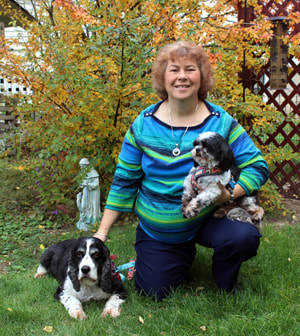 For a person like me, October 4 is a special day – it’s World Animal Day. Started in the United Kingdom, this special day was created to bring greater awareness to the plight of animals and promote better animal welfare throughout the world.
For a person like me, October 4 is a special day – it’s World Animal Day. Started in the United Kingdom, this special day was created to bring greater awareness to the plight of animals and promote better animal welfare throughout the world. Celebrated in different ways in different countries, the goal of this day is to increase awareness and education, thereby, creating “a world where animals are always recognised as sentient beings and full regard is always paid to their welfare.”
I love that mission. In so many places across the world, animals are regarded as property, and therefore, disposable, useless, and of little or no regard. Dogs are sold in Asian meat markets; elephants, rhinos, walrus, and bears are killed for horns, ivory, gall bladders and paws for men’s sexual prowess drugs and as a “food delicacy;” and wild horses, monkeys, tigers, and others are killed for livestock pasture, rice fields, and farms in rainforests. Just as bison were slaughtered to the brink of extinction during 1800s America to subdue native peoples and set up Caucasian farms and ranches, so, too, are other regions of the world adversely impacting habitats and animals.
In western America, that fate is manifested in this day and age by the removal of the gray wolf and grizzly bear from the endangered species list.
I once lived in grizzly bear country – on the western edge of Yellowstone National Park. Humans and bears learned to live together, with the animals only killed when they attacked someone. Often, those attacks were human-caused: people leaving out garbage, dog food, bird seed, and other temptations; the bears, like most creatures, went for the easy food, just like Yogi and the pick-a-nic basket. If people confined food items and garbage, bears would not be attracted, and therefore, there would be less conflict with humans. Yet, people continue to want to establish domain and subdue whatever they feel gets in their way. Humans and animals CAN co-exist as long as people are willing to take the risks associated with living with wildlife. After all, the animals called these areas home long before humans brought in their cattle, sheep, and farms.
As a Christian, I believe God made us all, animals and humans (see Genesis 1;20 - 26). Humankind is supposed to be His crown of creation (we often don’t act that way!); animals were made to be companions for us. Interestingly, God provided plants for both animals and humans to eat; there wasn’t a carnivorous creature in the Garden of Eden (see Genesis 1: 29 – 31). God established humans to have dominion over His created works; however, dominion doesn’t mean conquering – it means stewardship, which means caregiver. We are to take care of what He made, not abuse His creation.
World Animal Day is this Thursday, October 4. Show your support for animals, including pets, by doing something to help the cause. Serve at an animal shelter or rescue, at a nature preserve or sanctuary; clean up a lake or river near you; pick up trash in your community; educate others of the importance of habitat and the value and joy of interacting with animals, whether wild or domestic; set up a bird feeding area in your garden, backyard or patio; and share what you’re doing and what is being done around the world via social media.
We can all make a positive difference in the lives of animals, in the habitats of our local communities, and positively affect creatures and creation around the world. Each of us has a part we can play to care for nature and ensure animals, birds, and habitats are still here for future generations.

Published on October 02, 2018 04:00
September 24, 2018
why should we be concerned about rabies?
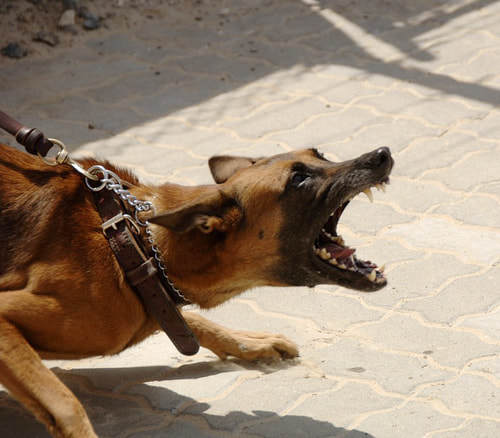 Our veterinarians recommend we vaccinate our pets against rabies, and many American communities require such vaccines. Why should we as pet owners and community residents be concerned about rabies?
Our veterinarians recommend we vaccinate our pets against rabies, and many American communities require such vaccines. Why should we as pet owners and community residents be concerned about rabies?Potential Exposure
A friend of mine who lives in Montana can attest to the need for rabies awareness and vaccinations. Earlier this year she received a major leg injury from a dog bite. She’s not unfamiliar with dogs; in fact, she was conducting an obedience class in her town’s park when the attack happened. Turns out the dog that inflicted the injury had not been vaccinated against rabies.
“Anyone who even touches an animal – dog, cat, horse, bat, whatever – that has rabies, has to get a shot, which can cost $3,000. If the person is bitten, they basically are re-traumatized because the first shot goes into the area where the bite is – think of children who might have to go through that,” she said.
In her community, there were nine bite incidents from January to mid-August, she added. My Montana friend needs to be monitored for the next two years to insure she doesn’t contract rabies.
Although a human contracting rabies is rare, it does happen. According to the Centers for Disease Control, one to three cases of human rabies are reported each year. “The number of human rabies deaths in the United States attributed to rabies has been steadily declining since the 1970’s thanks to animal control and vaccination programs, successful outreach programs, and the availability of modern rabies biologics. Dog rabies vaccination programs have halted the natural spread of rabies among domestic dogs, which are no longer considered a rabies reservoir in the United States,” according the CDC’s website. However, the organization’s website text adds, “each year between 60 to 70 dogs and more than 250 cats are reported rabid. Nearly all these animals were unvaccinated and became infected from rabid wildlife (such as bats, raccoons, and skunks).”
I live in Wyoming, and the CDC notes that an elderly woman in the state contracted and died from rabies in 2015 through an encounter with a bat.
According to the Mayo Clinic, a human who is bitten by a rabid animal receives a series of four shots given over 14 days, plus one that’s fast-acting (rabies immune globulin) given as soon as possible after the bite. Read more here: https://www.mayoclinic.org/diseases-conditions/rabies/diagnosis-treatment/drc-20351826.
World Rabies Day
Friday, September 28 is World Rabies Day. Started 11 years ago, this special day was created to raise awareness about rabies and bring together partners to improve prevention and control efforts throughout the world. World Rabies Day is observed in many countries, including the United States. About 59,000 people die from rabies throughout the world each year, according to the CDC. Vietnam, Ethiopia, Haiti, Mexico, and India are some of the countries where people have been exposed to rabies and where the disease is still rampant not only in wild animals, but also in dogs.
According to the American Veterinary Medical Association, nearly 5,000 cases of animal rabies was reported in 2016. The disease attacks the nervous system and, once infected, death of the animal is certain. The disease passes from animal to animal (or human) when the virus is secreted via the animal’s saliva oftentimes by a bite from the infected animal. Rabies can also be transmitted when saliva from a rabid animal comes in contact with an open cut on the skin or the eyes, nose, or mouth of a person or other animal. Only mammals contract rabies. Vaccines are available for cats, dogs, ferrets, horses, cattle and sheep.
Prevention
The best way to prevent rabies in our pets to have them vaccinated. Raccoons, skunks, and bats are prone to rabies and these wild animals often come into yards and houses. Stray dogs and cats can also be transmitters of rabies, therefore, protect your beloved pet from potential contact with a stray, or unvaccinated, dog or cat. This also can help protect you and your family plus people in your community. If you travel outside the United States, learn what you need to know about rabies in other countries by visiting this website: https://wwwnc.cdc.gov/travel/yellowbook/2018/infectious-diseases-related-to-travel/rabies.
The theme for this year’s World Rabies Day is Rabies: Share the Message, Save a Life. Help educate people on the importance of rabies awareness and vaccinating pets against the disease.
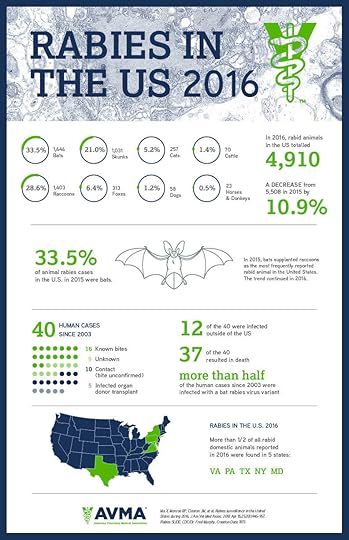
Published on September 24, 2018 17:00
September 19, 2018
deafness in dogs: how to know and what to do
 Is your dog deaf? How would know if it was?
Is your dog deaf? How would know if it was?Like many humans, our canine companions can lose their hearing as they age. My springer/cocker mix, Mary, is now more than twelve years old, and my husband and I have noticed a change – more than one, actually. First, she barks more than she did six months or a year ago. Normally a quiet dog who barked occasionally while in the back yard (after all, we have neighbor dogs and squirrels run through the yard!), she’s started to bark while in the house (very unusual for her) and more so outdoors. Secondly, she doesn’t respond to our voices as readily as she once did. And, third, she is sleeping more deeply than ever. We suspect she is losing her hearing.
Signs of Deafness
According to PetMD.com, these are some of the signs of hearing loss in dogs:Unresponsive to everyday soundsUnresponsive to its nameUnresponsive to the sounds of squeaky toysNot woken by a loud noise
Causes of Deafness
There are a myriad of issues which can cause a dog to become deaf, including the natural aging process. As mentioned, our Mary dog is going on thirteen years of age, and therefore, a senior dog. She also has several allergies and subsequently, her ears are prone to bacterial infections. Inflammation of the outer, inner, or middle ear can cause hearing loss. Here are a few other potential causes:Degenerative nerve changes in elderly dogsAntibioticsChemotherapy drugsTumors or cancer involving nerves in the ear
Some breeds of dogs are susceptible to deafness, therefore, puppies can be prone to the condition (called congenital). Such breeds include cocker spaniels (Mary is part cocker), Dalmatians, West Highland terriers, and Boston terriers, among others.
Having an older dog like Mary and noticing behavior changes, including sleep patterns, can also help you determine if your dog is losing its hearing. For example, if you think your dog is sleeping heavier than normal and s/he doesn’t wake up to noises in your home, or if s/he startles from deep sleep, then your canine companion may be going deaf.
How Can You Know?
DeafDogsRock.com suggests some activities to test your dog’s hearing ability.Stand behind your dog and clap your hands or jingle a set of keys. If your dog’s ears don’t move, twitch, or its head doesn’t turn towards the sound, there is a good chance your dog has probably gone deaf or at least is going deaf.Does your dog react to door bells, neighborhood dogs barking, or sirens as it did in the past? If not reacting to those noises now but used to, chances are hearing loss has occurred in your dog.
A Word on Deaf Cats
Like certain breeds of dogs, there are certain cat breeds that are more susceptible to hearing loss; those include Ragdolls and white Persians. In fact, white cats with blue eyes are the most prone to deafness. If you are the pet guardian of a cat and you’re concerned about hearing loss, PetMD.com and PetWave.com are good resources for you: https://www.petmd.com/cat/conditions/ears/c_ct_deafness
https://www.petwave.com/Cats/Health/Deafness.aspx
What to Do?
First, consult with your veterinarian. S/he may find an ear infection that can still be treated. If that’s not the case, seek advice from your pet’s vet.
Second, if you haven’t taught your furry friend hand signals yet, do so. Dogs learn quickly, even older canines. As long as your dog can still see, communicating via hand signals is a major asset and provides your dog the mental stimulation it needs. Train your dog basic commands with hand signals. Keeping your deaf pet safe is of even greater importance as it will not hear cars coming or other noises. Find training tips for deaf dogs here: https://deafdogsrock.com/category/training-tips.
You may need to adjust how you interact with your deaf dog, but living with a canine with hearing loss is not a huge problem. Learn more about living with a deaf dog here: https://www.cesarsway.com/dog-care/senior-dogs/preparing-a-dog-that-is-going-blind-or-deaf
No matter the type of pet you have, its health and happiness depend on you. If your furry friend is or becomes deaf, take the time to help both you and your pet adjust – there are many resources on and off-line available to help you do just that.
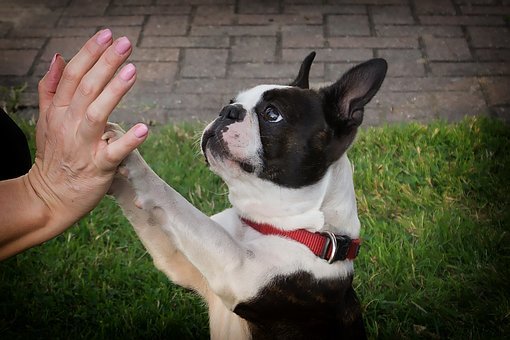
Published on September 19, 2018 06:02
September 11, 2018
Hiccups in Dogs: Cute or Concerning?
 Does your dog ever get the hiccups? Mine does.
Does your dog ever get the hiccups? Mine does.Sweet Jeremiah, who has been part of my household for a year now, occasionally gets a bout of the hiccups. I don’t remember this experience happening to previous dogs I’ve had, but Jeremiah gets them somewhat regularly. I admit, it’s cute to watch his 12-pound body twinge and a slight “burruup!” come from his tiny mouth. Recently, though, I began to wonder if many dogs get the hiccups since I’ve not had the experience before adopting our little Shih Tzu. Here’s what I learned researching “hiccups in dogs.”
According to PetMD.com:Hiccups are involuntary contractions of the diaphragm, and though normally, movements of the diaphragm are smooth and regular, however, a hiccup occurs when the muscle suddenly spasms, which is similar to what people experience.Hiccups happen in dogs for a variety of reasons, such as when dogs are excited or stressed, when they inhale an irritant, when they eat or drink too fast, or when participating in energetic play; rapid breathing can also bring on a bout of hiccups.Hiccups are more likely to happen in puppies than adult dogs (Jeremiah is nearly 6 years old, so he’s certainly more adult than puppy) because puppies are more excitable and possess more energy.Also, according to the Doggington Post, some types of dog food can cause hiccups, especially those with high amounts of grain. Therefore, you may want to investigate what’s in your dog’s food.
If your dog does experience hiccups, here are a few things you can do to assist your canine friend through the experience:Massage your dog’s chest to help relax the diaphragm; the American Kennel Club recommends this approach, stating that laying a dog on its back and giving it a nice tummy rub can help relax the animal and help hiccups subside.Add syrup, honey, or sugar to your dog’s water (no solid food due to choking hazards).Gently startle your pet (an act NOT recommended by the AKC)Encourage light exercise – that may help change your dog’s breathing pattern.
Hiccups in dogs are generally not life-threatening nor require a trip to the vet. Just as with humans, they eventually go away; in fact, doggie hiccups usually only last a few minutes. However, there are rare instances when hiccups can be a sign of a more serious health problem, such as respiratory defects, pneumonia, asthma, pericarditis, or heat stroke.
If your puppy or adult dog experiences hiccups, don’t be overly concerned unless the episode lasts longer than 30 minutes. Then, experts say, contact your veterinarian for recommendations, which may include making an appointment to learn if there is an underlying health issue that needs to be investigated.
Here's to cuteness hiccups, not concerning ones!
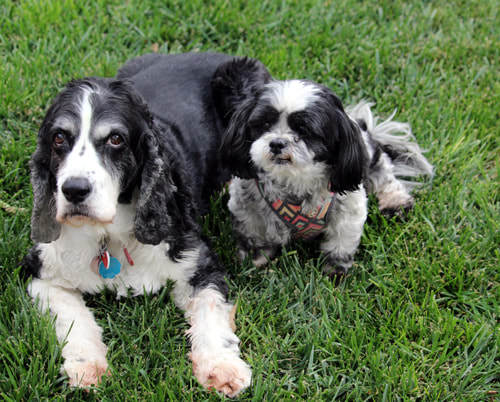
Published on September 11, 2018 03:30



